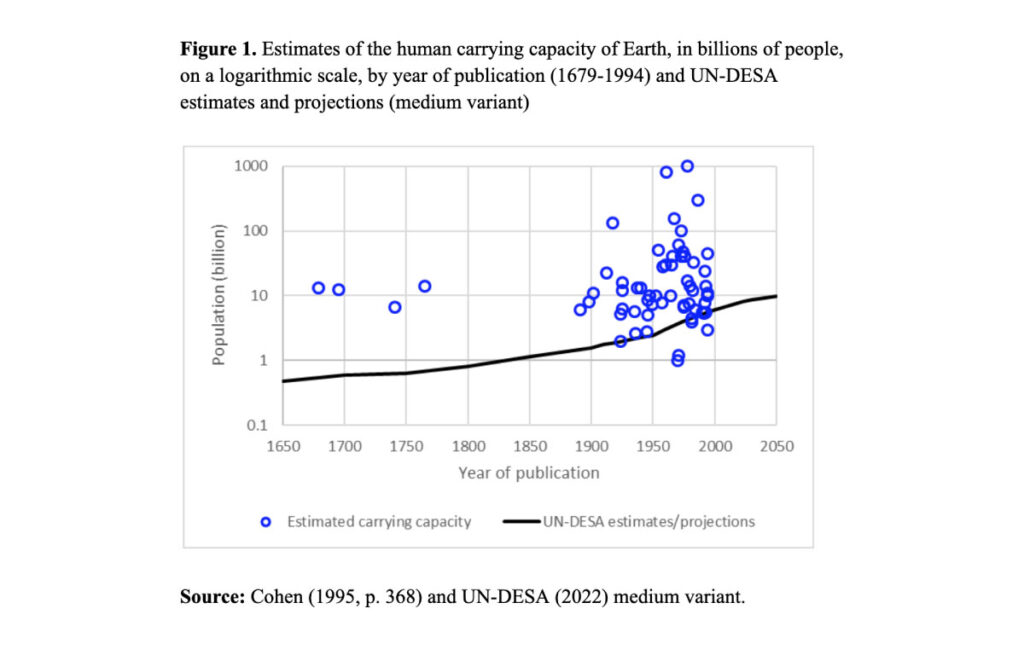Can Earth support 4 billion people sustainably and well?

On October 18, 2023, the International Union for the Scientific Study of Population (2023) broadcast a Yes-or-No debate on the statement: “The population of humans that can be supported sustainably on the planet at a reasonable standard of living is below 4 billion.” Here is an abridged version of Joel E. Cohen’s introduction to and background for the debate.
Professor Stan Becker, who proposed the debate (UN 2023), asked me to provide background for it, probably because some time ago (Cohen 1995, p. 368) I reviewed 66 published estimates of the human carrying capacity of Earth, as defined in various ways by the publications. The results of 65 of them (omitting one estimate of 1016 – 1018 people) are summarized in Figure 1, where the horizontal axis is the year of publication and the vertical axis (billions of people), on a logarithmic scale, is the estimated human carrying capacity.
The earliest estimate was by Antoni van Leeuwenhoek, inventor of the microscope, in 1679. He estimated that the world could support 13.4 billion people. Estimates in the last half of the 20th century ranged from less than 1 billion to more than 1,000 billion.
Not all these estimates can be right, and some may not correspond to “the population of humans that can be supported sustainably on the planet at a reasonable standard of living.” Moreover, they vary increasingly with time instead of converging to a single best estimate. Some of these figures are more political than scientific: the high estimates are intended to show that there is no present problem with continued population growth, while the low estimates are intended to show that Earth already has more people than it can support sustainably. Half of them lie between 4 billion and 16 billion people.

Van den Bergh and Rietveld (2004) reviewed 94 “limits to world population”: “When taking all studies into account, the best point estimate is [the median estimate,] 7.7 billion people; the lower and upper bounds, given current technology, are 0.65 billion and 98 billion people, respectively.” “Given current technology,” is only one of the factors upon which estimates are conditional.
Choices and constraints in populations, economics, environments, and cultures
Multiple factors influence whether Earth can sustainably support 4 billion or any other number of people. We can describe these factors at three levels of detail.
At the most general level, Earth’s human carrying capacity depends on choices and constraints. Humans do not fully understand Earth’s biological, chemical, and physical responses to past and future perturbations from humans and from nature. Hence our understanding of constraints on future human populations is incomplete. Likewise, future human choices may affect which constraints apply. Unanticipated constraints may affect which choices humans will have.
In more detail, constraints and choices affect populations, economics, environments, and cultures. These four factors interact to influence Earth’s capacity to support people sustainably. For example, culture affects economics (and vice versa) in ways which depend partly on demography (e.g., through urbanization and age structure). The interaction between culture, economics, and demography influences and is influenced by environments (e.g., through biodiversity, infectious viruses, climate, and earthquakes).
At a third, finer level of detail, how many people Earth can support sustainably and well depends on answers to at least 11 questions.
1) What will be the average level of material and cultural well-being, in terms of food, fiber, water, housing, industrial output, health, sanitation, energy, education, and travel, for example?
2) What will be the distribution of material and cultural well-being? What inequalities will we choose or accept in income, wealth, “happiness”, health, and other “goods,” among nations and among individuals within nations? How will we measure inequalities?
3) What technologies will we use to produce goods and services?
4) What will be our domestic and international political arrangements? What will be our individual freedoms, procedures for political change, means of resolving conflicts?
5) What will be our domestic and international economic arrangements? What will be our incentives for economic productivity, modes of production, trade agreements or tariffs, and regulation within and among nations?
6) What will be our domestic and international demographic arrangements regarding, for example, birth, death, migration, marriage, family, households, age structure, and cities?
7) What will be our physical, chemical, and biological environments, including future biological diversity, exposure to infectious agents, and climate?
8) What will be our desired variability or stability of population size? For the last 12,000 years, humans have enjoyed a warm interglacial interval since the last ice age. The previous interglacial occurred 115,000-130,000 years ago, so biologically modern humans have experienced the most recent ice age and could survive a future ice age. Let us assume that Earth can support sustainably at most 1 billion people during an ice age. Do we want a total population size that remains at 1 billion people during ice ages and interglacials, or do we want a total population size that surges to 8 billion or more during interglacials and subsides to 1 billion during ice ages? How much variability or stability do we want?
9) Do we prefer risk or robustness? For example, do we continue to build cities in floodplains and active earthquake zones, or do we limit settlements to safe areas?
10) What is our time horizon? For the next five years we will have plenty of oil. “Given current technology,” it seems very unlikely that we will have plenty of oil for the next 500 years.
11) What will be our values, tastes, and fashions? Will we value jaguars with four legs or Jaguars with four wheels? Parks or parking lots? To settle our political, economic, cultural, and personal differences, will we choose violence or talk?
A better question
Earth’s human carrying capacity is so difficult to define precisely, so sensitive to subtle assumptions, and so dependent on an unknowable future that it has questionable scientific content. I believe we need to change our focus from Earth’s human carrying capacity to a more practical question.
What do we need to do and learn now and in the coming 25 years (roughly one generation) to improve the security, health, prosperity, and well-being of people we have now and will add in the next 25 years, while respecting our obligations to future generations of humans and other life forms?
Three panaceas have been proposed: bigger pie, fewer forks, and better manners.
• The advocates of a bigger pie recommend increasing the productivity of people and machines.
• The advocates of fewer forks recommend slowing or ending population growth through voluntary reductions in fertility.
• The advocates of better manners recommend reducing violence, corruption, inequalities, barriers to economic and technological efficiency, and unwanted material byproducts of consumption and production.
Many advocates insist on one of these panaceas to the exclusion of the other two. I believe we need all three.
References
Cohen, Joel E. 1995 How Many People Can the Earth Support? W. W. Norton, New York. [Japanese translation: Shin-Jinkou-Ron (New Principle of Population) by Nanako Shigesada, Hiromi Seno and Fugo Takasu. Tokyo: Nosan Gyosan Bunka Kyokai. Italian translation: Quante persone possono vivere sulla terra? by Nanni Negro. Bologna: Il Mulino.]
Cohen, Joel E. 2017 How many people can the Earth support? Journal of Population and Sustainability 2(1):37-42. [In French: Cohen, Joel E. 2017 La capacité humaine de la Terre. Fécondité: un enjeu pour la planète? Revue Projet (Society of Jesus, France) 359:78-83.]
UN-DESA (2022) World Population Prospects 2022 Revision, New York.
Van Den Bergh, Jeroen C. J. M. and Rietveld, Piet 2004 Reconsidering the limits to world population: meta-analysis and meta-prediction. BioScience 54(3):195-204.